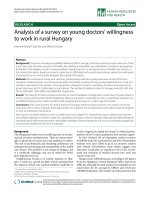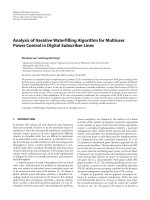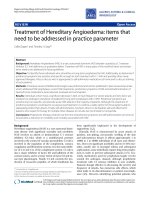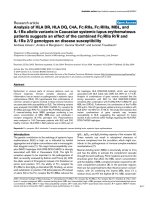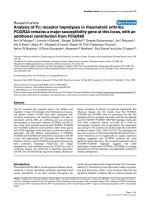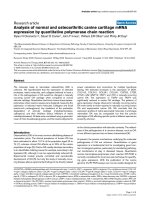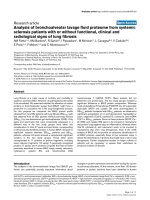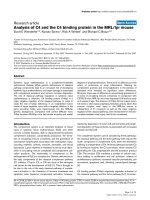Báo cáo y học: " Analysis of HIV-1 Vpr determinants responsible for cell growth arrest in Saccharomyces cerevisiae" ppt
Bạn đang xem bản rút gọn của tài liệu. Xem và tải ngay bản đầy đủ của tài liệu tại đây (801.79 KB, 11 trang )
BioMed Central
Page 1 of 11
(page number not for citation purposes)
Retrovirology
Open Access
Research
Analysis of HIV-1 Vpr determinants responsible for cell growth
arrest in Saccharomyces cerevisiae
Xiao-Jian Yao
1,2
, Nicole Rougeau
1
, Ghislaine Duisit
1
, Julie Lemay
1
and
Éric A Cohen*
1
Address:
1
Laboratoire de Rétrovirologie Humaine, Département de Microbiologie et Immunologie, Faculté de Médecine, Université de Montréal,
Montréal, Québec H3C 3J7, Canada and
2
Current address : Dept. of Medical Microbiology, University of Manitoba, Basic Medical Sciences
Building, 730 William Avenue, Winnipeg, Manitoba R3E 0W3, Canada
Email: Xiao-Jian Yao - ; Nicole Rougeau - ; Duisit Ghislaine - ;
Julie Lemay - ; Éric A Cohen* -
* Corresponding author
Abstract
Background: The HIV-1 genome encodes a well-conserved accessory gene product, Vpr, that
serves multiple functions in the retroviral life cycle, including the enhancement of viral replication
in nondividing macrophages, the induction of G2 cell-cycle arrest, and the modulation of HIV-1-
induced apoptosis. We previously reported the genetic selection of a panel of di-tryptophan (W)-
containing peptides capable of interacting with HIV-1 Vpr and inhibiting its cytostatic activity in
Saccharomyces cerevisiae (Yao, X J., J. Lemay, N. Rougeau, M. Clément, S. Kurtz, P. Belhumeur, and
E. A. Cohen, J. Biol. Chem. v. 277, p. 48816–48826, 2002). In this study, we performed a mutagenic
analysis of Vpr to identify sequence and/or structural determinants implicated in the interaction
with di-W-containing peptides and assessed the effect of mutations on Vpr-induced cytostatic
activity in S. cerevisiae.
Results: Our data clearly shows that integrity of N-terminal α-helix I (17–33) and α-helix III (53–
83) is crucial for Vpr interaction with di-W-containing peptides as well as for the protein-induced
cytostatic effect in budding yeast. Interestingly, several Vpr mutants, mainly in the N- and C-
terminal domains, which were previously reported to be defective for cell-cycle arrest or apoptosis
in human cells, still displayed a cytostatic activity in S. cerevisiae and remained sensitive to the
inhibitory effect of di-W-containing peptides.
Conclusions: Vpr-induced growth arrest in budding yeast can be effectively inhibited by GST-
fused di-W peptide through a specific interaction of di-W peptide with Vpr functional domain,
which includes α-helix I (17–33) and α-helix III (53–83). Furthermore, the mechanism(s) underlying
Vpr-induced cytostatic effect in budding yeast are likely to be distinct from those implicated in cell-
cycle alteration and apoptosis in human cells.
Background
Human immunodeficiency virus 1 (HIV-1) Vpr is a small
virion-associated protein that is incorporated into virions
through a specific interaction with the p6 domain of the
p55
gag
precursor protein [1,2]. Increasing evidence sug-
gests that Vpr plays important roles during HIV-1
Published: 16 August 2004
Retrovirology 2004, 1:21 doi:10.1186/1742-4690-1-21
Received: 30 June 2004
Accepted: 16 August 2004
This article is available from: />© 2004 Yao et al; licensee BioMed Central Ltd.
This is an open-access article distributed under the terms of the Creative Commons Attribution License ( />),
which permits unrestricted use, distribution, and reproduction in any medium, provided the original work is properly cited.
Retrovirology 2004, 1:21 />Page 2 of 11
(page number not for citation purposes)
replication and pathogenesis. First, virion-associated Vpr
has been shown to act early in viral infection as a facilita-
tor of HIV-1 preintegration complex (PIC) entry through
the limiting nuclear pore. This activity of Vpr is thought to
be responsible for Vpr's ability to enhance HIV-1 replica-
tion in nondividing cells, most notably in terminally dif-
ferentiated macrophages [3-5]. Second, expression of Vpr
induces a G2 cell cycle arrest, which is thought to indi-
rectly enhance viral replication by increasing transcription
from the HIV-1 long terminal repeat (LTR) [6,7].
Even though the molecular mechanism of Vpr-mediated
cell-cycle G2 arrest is still obscure, it has been known that
Vpr expression leads to inactivation of the mitotic
p34cdc2/cyclinB complex in human cells [8,9] as well as
in fission yeast Schizosaccharomyces pombe (Sc. Pombe) [10-
14]. Involvement of protein phosphatase 2A (PP2A),
Wee1, Cdc25C, and 14-3-3 proteins has also been impli-
cated [8-12,14] but the host cell proteins directly engaged
by Vpr are not yet identified. Noteworthy, HIV-1 Vpr
expression induces also a growth arrest in Saccharomyces
(S.) cerevisiae [15-17]. Deletion mapping studies showed
that the C-terminal 33 amino acids, including the H(S/
F)RIG motif, contributed to this cytostatic effect [15,18].
Although this region has also been implicated in Vpr-
mediated cell-cycle dysregulation in mammalian and S.
Pombe cells [19-25], the molecular mechanism of Vpr-
growth arrest in budding yeast is thought to be distinct
since growth arrest occurs independently of any evident
block at the G2/M transition [16]. Accordingly, it has been
reported that the G2/mitosis transition in budding yeast is
regulated differently than in mammalian cells and fission
yeast [26,27]. Indeed, Vpr cytostatic effect observed in S.
cerevisiae has been proposed to result from gross mito-
chondrial dysfunction [17] and/or cytoskeletal defects
[16], rather than a cell cycle G2 arrest.
In addition to nuclear import and cytostatic activities,
HIV-1 Vpr exhibits cytotoxic properties. Elevated intracel-
lular expression or addition of extracellular Vpr or derived
peptides results in proapoptotic effects in human cells
including neurons [6,28,29] as well as cytotoxicity in bud-
ding and fission yeasts [30,31]. Jacotot et al. have pro-
vided evidence indicating that extracellular Vpr or
peptides derived from Vpr C-terminus induce mitochon-
drial dysfunction in human cells by a mechanism involv-
ing a specific binding to the adenine nucleotide
translocator (ANT), a component of the permeability
transition pore complex (PTPC) in the mitochondrial
membrane. The resulting mitochondrial membrane per-
meabilization (MMP) leads to a decreased membrane
potential and the release of cytochrome c and apoptosis
inducing factor (AIF) [32,33]. This Vpr-mediated MMP is
thought to initiate cell death through both caspase-
dependent and independent mechanisms in human cells
as well as cytotoxicity in budding yeast [32-37]. In addi-
tion, it has also been shown that extracellular Vpr is capa-
ble of forming cation-selective ion channels in planar
lipid bilayers, which can depolarize intact cultured neu-
rons, thus leading to cell death [28].
In a previous report, we have shown that expression of
genetically-selected glutathione-S-transferase (GST)-fused
di-tryptophan (di-W)-containing peptides inhibited Vpr-
mediated growth arrest in S. cerevisiae presumably by
interacting with Vpr [38]. Interestingly, these, di-W-con-
taining peptides were also able to inhibit Vpr biological
activities, including nuclear import, cell cycle G2 arrest
and apoptosis, in mammalian cells or HIV-1 infected T
cells [38]. Even though the inhibitory effect of these di-W-
containing peptides correlated with their ability to inter-
act with Vpr in budding yeast, the detailed mechanism
underlying their mode of action remains to be defined. In
addition, it is still unclear whether the growth arrest activ-
ity of Vpr in budding yeast is related to specific biological
activities of Vpr in human cells. In this study, we have per-
formed a mutagenic analysis of Vpr to identify Vpr
domains important for di-W peptide binding and cyto-
static activity in S cerevisiae. Results reveal that the inhibi-
tory di-W-containing peptides target specifically a
functional domain of Vpr directly involved in growth
arrest in budding yeast. Furthermore, several previously
well-characterized Vpr mutants unable to induce cell-cycle
dysregulation and/or apoptosis in mammalian cells still
exhibit strong growth arrest activity in budding yeast,
indeed suggesting that Vpr carries out distinct functions in
S. cerevisiae.
Results
Analysis of Vpr sequence and/or structural determinants
implicated in the interaction with di-W-containing
peptides
We have previously used a genetic selection system in S.
cerevisiae budding yeast and selected a panel of di-W-con-
taining GST-peptides that specifically inhibit Vpr-medi-
ated yeast growth arrest function presumably through
their ability to bind HIV-1 Vpr [38]. In this study, we fur-
ther investigated the molecular mechanism of this inhibi-
tion using a newly selected GST-fused di-W peptide
WWSFKSV (GST-B4), which displayed an enhanced abil-
ity to bind Vpr and inhibit its growth arrest activity in bud-
ding yeast (Fig. 1A and 1B).
Structural studies performed with synthetic forms of Vpr
indicate that Vpr is characterized by a well-defined
gamma turn (14–16)-alpha helix (α-helix I: 17–33)-turn
(34–36), followed by an alpha helix(α-helix II: 40–48)-
loop (49–54)-alpha helix (α-helix III: 55–83) domain
and ends with a very flexible C-terminal arginine-rich
sequence [39]. The α-helical determinants where shown
Retrovirology 2004, 1:21 />Page 3 of 11
(page number not for citation purposes)
to be required for Vpr virion incorporation, nuclear local-
ization and oligomerization [39-44] and are believed to
be involved in heterologous protein binding [45]. The
arginine rich C-terminal region of Vpr has not been
shown to have a predicted structure, however this region
harbors protein phosphorylation sites and plays an
important role in cell cycle G2 arrest and the nuclear local-
ization of the protein in mammalian cells [6,31,46]. To
further investigate the sequence and/or structural require-
ment of Vpr for GST-B4 binding, mutations were intro-
duced in p424Gal1-Vpr expressor to target different
regions of Vpr (Fig. 2A). The N-terminal Q3R mutant was
shown to affect Vpr proapoptotic activity during HIV-1
replication [47]. Four amino acids Glu21, Leu23, Glu25
and Ala30 were separately changed to Lys or Phe (E21K,
L23F, E25K and A30F) in order to disrupt the amphipatic-
ity of the first α-helix [39] (Fig. 2A). The F34I was intro-
duced in a γ-turn region which is just after the α-helix I
GST-B4 peptide binds to HIV-1 Vpr in S. cerevisiae and rescues cell growthFigure 1
GST-B4 peptide binds to HIV-1 Vpr in S. cerevisiae and rescues cell growth. (A) GST pull-down from yeast extracts. S. cerevisiae
HP16 strain co-transformed with GST or GST-B4 plasmids and (R+) or (R-) Vpr expressor were metabolically-labeled with
150 µCi of
35
S-Translabel in Vpr-inducible medium. Half volume of the cell extract was used for GST pull-down, while the
remaining lysates were subjected to immunoprecipitation with polyclonal anti-Vpr antiserum. Total and GST-bound radiola-
beled Vpr proteins were detected by autoradiography after SDS-PAGE. (B) GST-B4 suppression of Vpr-induced cell growth
arrest. Yeast co-transformants were grown in non-inducible selective medium for two days. Similar number of yeast cells were
then serially diluted, spotted onto either Vpr non-inducible (Trp
-
/Ura
-
, 2% raf) or Vpr-inducible plates (Trp
-
/Ura
-
, 2% gal) and
incubated for 3 to 5 days to evaluate their growth rates. This data is representative of results obtained in two independent
experiments
R-
GST-B4
R-
R+
GST
R+
Bound Vpr
A.
Total Vpr
GST-B4/R+
GST/R-
GST/R+
Raffinose Galactose
B.
10
-1
10
-2
10
-3
10
-4
10
-1
10
-2
10
-3
10
-4
Yeast dilutions Yeast dilutions
GST
pull down
Anti-Vpr IP
Retrovirology 2004, 1:21 />Page 4 of 11
(page number not for citation purposes)
[39]. The R62P and I63K mutations introduced in the
third helix were aimed at interfering with the integrity of
the α-helix and are known to abolish Vpr nuclear localiza-
tion [41]. Four mutants in the C-terminal region, includ-
ing, R77Q, S79A, R80A and R87, 88, were generated to
replace positively-charged arginine residues or to remove
the critical phosphorylation site (Ser 79) of the protein.
Vpr mutants S79A and R80A were reported to be defective
for cell cycle G2 arrest activity in mammalian cells, while
the proapoptotic activity of R77Q was severely attenuated
[6,24,48]. In addition, a frameshift mutation (R77fs) [40]
and a truncation mutation (R86stop), which prematurely
terminate the protein at amino acid 77 and 86 respectively
were also constructed.
To determine the impact of the Vpr mutations on GST-B4
peptide binding, HP-16 yeast co-transformed with
mutated-Vpr expressors and either GST or GST-B4 vectors
were radio-labeled in Vpr-inducible medium and sub-
jected to GST pull-down assays (Fig. 2B), as described in
HIV-1 Vpr mutants exhibit differential GST-B4 binding abilitiesFigure 2
HIV-1 Vpr mutants exhibit differential GST-B4 binding abilities. Each Vpr mutant used in this study with the exact location of
the introduced mutation is described (A). (B) GST pull-down using a panel of Vpr mutants. Assays were performed as
described in Fig. 1A. Protein extracts were prepared from radiolabeled cells expressing GST (lanes 1–2) or GST-B4 proteins
(lanes 3–17) alone (R-), or in presence of wild-type Vpr (R+) or different mutant proteins, as indicated. Vpr bound to GST-B4
(upper panel) and the total amount of Vpr as determined using immunoprecipitation with anti-Vpr antiserum (lower panel)
were separated by SDS-PAGE and detected after autoradiography. (C) The percentage of GST-B4-bound Vpr relative to the
total amounts of Vpr for each mutant was quantified by autoradiography scanning and the level of wild type Vpr bound to GST-
B4 was arbitrarily set as 100%. These data are representative of at least two independent experiments.
A.
Q3R
E21K
L23F
I63K
R62P
A30F
F34I
R77Q
S79A
R80A
RR87,88AA
R86stop
R77fs
MEQAPEDQGPQREPYNEWTLELLEELKSEAVRHFPRIWLHNLGRHIYETYGDTWAGVEAIIRILQQLLFIHFRIGCRHSRIGVTRQRRARNGASRS
α- helix 1 α-helix 3α−helix 2
basic aa rich region
E25K
F
K
F
R
I
K
Q
A
A
AA
P
K
R-
R+
R-
GST-B4GST
B.
R-
R+
R-E21K
R-F34I
R86stop
R-87,88
Bound Vpr
Total Vpr
GST-
GST-B4-
R-L23F
R-R62P
R-I63K
R-A30F
R-R77fs
R-R80A
R-E25K
R+
1 2 3 4 5 6 7 8 9 10 11 12 13 14 15 16 17
C.
0
25
50
75
100
R+
R
-
E
2
5
K
R86stop
R-87,88
R
-
R
6
2
P
R
-
A
3
0
F
R
-
E
2
1
K
R
7
7
f
s
R
-
R
8
0
A
R
-
I
6
3
K
R
-
F
3
4
I
R
-
L
2
3
F
Bound Vpr (%)
Retrovirology 2004, 1:21 />Page 5 of 11
(page number not for citation purposes)
Materials and Methods. Moreover, the amount of wild
type Vpr or each mutant bound to GST-B4 peptide was
evaluated by laser densitometric scanning of bands in
autoradiograms and normalized to the total amounts of
Vpr and GST proteins that were expressed in each trans-
formants. The amounts of wild type Vpr bound to GST-B4
was arbitrarily set as 100% (Fig. 2C). Results of figure 2B
reveal that all Vpr mutants were expressed at comparable
levels, as determined by Vpr immunoprecipitation of
induced-cell lysates with the exception of Vpr (R77fs),
which indeed was previously reported to be less stable
than wild type Vpr [40] (Fig. 2B, lower panel). While no
Vpr interacted with GST (Fig. 2B, upper panel, lane 2),
similar levels of wild type Vpr, E25K, F34I, I63K, R77fs,
R80A, R87, 88 and R86stop mutants were pulled-down
with GST-B4 (Fig. 2B, upper panel and 2C). Similar results
were obtained for Vpr mutants Q3R, R77Q, S79A (data
not shown). In contrast, E21K, L23F, A30F and R62P
mutants, which are respectively located in α-helix I and α-
helix III regions, were not co-pulled down with GST-B4
(Fig. 2B (upper panel, lanes 5, 7, 8 and 14) and 2C).
Taken together, these results suggest that the integrity of
the N-terminal α-helix I and the α-helix III of Vpr are cru-
cial for GST-B4 binding, whereas the C-terminal domain
is dispensable for the interaction.
Vpr mutants defective for GST-B4 binding are unable to
arrest yeast cell growth
We next tested the growth arrest activity of these Vpr
mutants in HP-16 yeast. Growing yeast cells transformed
with the empty vector (R-), wild-type (R+) or mutated Vpr
expressors were serially diluted and spotted onto either a
Vpr non-inducible plate (Trp
-
, 2% raf) or a Vpr-inducible
plate (Trp
-
, 2% gal). Cell growth was evaluated following
an incubation of 3–5 days at 30°C (Fig. 3). In Vpr non-
inducible plate, all yeast transformants grew at similar rate
(Fig. 3, left panel). Upon galactose induction, while the
empty vector (R-)-transformed yeast grew efficiently (Fig.
3, lanes 1, 8 and 15), the wild-type Vpr (lanes 2, 9 and 16),
the Q3R mutant and all proteins mutated in the C-termi-
nal region, including R77Q, S79A, R80A exhibited a pro-
found growth arrest activity (Fig. 3, right panel (lanes
10,13, 14 and 18). Similar results were obtained for R-
87,88 and R86stop mutants (data not shown), indicating
that the C-terminal arginine-rich region of Vpr is not
involved in budding yeast growth arrest activity. Of note,
R77fs showed an impaired growth arrest activity (Fig. 3,
lane 17), which is most likely due to the shorter half-life
of this truncated protein, as reported before [40]. In con-
trast, expression of helices I and III Vpr mutants, E21K,
L23F, A30F and R62P, which displayed a strong attenua-
tion of binding to GST-B4, did not lead to HP-16 budding
yeast growth arrest (Fig. 3, right panel, lanes 3, 4, 6 and
11). On the contrary, helix I or III mutants E25K, F34I,
and I63K, which were able to interact with GST-B4, still
exhibited growth arrest activity, even though at reduced
levels as compared to wild-type Vpr (Fig. 3, right panel, 5,
7 and 12). These results indicate that Vpr helices I and III
represent an important functional domain involved in
growth arrest in budding yeast.
GST-B4 inhibits the cytostatic activity of Vpr mutants and
rescues cell growth
To further investigate the correlation between the inhibi-
tory effect of GST-B4 and its Vpr-binding ability, GST or
GST-B4 were co-expressed with two GST-B4-binding
defective Vpr mutants E21K and L23F or with two GST-
B4-binding competent mutants E25K and F34I in HP-16
yeast and the resulting cell growth was monitored in Vpr-
inducible plates as described above. In agreement with the
data of figure 3, in the presence of GST alone, mutants
E25K and F34I induced significant yeast growth arrest,
while such activity was severely impaired for B4-binding
defective mutants E21K and L23F (Fig. 4, left panel). In
contrast, GST-B4 co-expression strongly inhibited the
growth arrest activity of the wild type Vpr, E25K and F34I
mutants and indeed restored their cell growth at a level
comparable to that of yeast cells expressing E21K or L23F
(Fig. 4, right panel). A weak inhibitory activity of B4 was
also observed with mutants E21K and L23F (lanes 3 and
4). It is possible that this may reflect a weak or instable
interaction between B4 and Vpr mutants E21K and L23F,
which could not be clearly detected in the binding exper-
iments (Fig. 3). Overall, these results clearly indicate that
GST-B4 specifically binds to structural determinants that
are important for inducing cell growth arrest. Moreover, as
described previously (38), the binding efficiency of B4
peptides correlates with the extent of the peptide inhibi-
tory activity.
Discussion
We have previously shown that GST-fused di-W-contain-
ing peptides were able to interact with HIV-1 Vpr and as a
result inhibit its multiple functions in budding yeast as
well as in HIV-1 infected T cells [38]. In the present study
we have further investigated the sequence and/or struc-
tural determinants required for Vpr/peptide interaction
and determined their impact on Vpr cytostatic activity in
budding yeast. Results clearly show that GST-fused B4
peptide interaction with Vpr involves the α-helical I and
III structure of Vpr. Mutations affecting the integrity of
these helical regions not only interfered with the interac-
tion with GST-B4 peptide, but also failed to induce a cyto-
static activity in budding yeast. Furthermore, Vpr mutants,
including Q3R, R77Q, R80A and S79A, yet defective for
cell-cycle arrest or apoptosis in mammalian cells, still
induced a growth arrest in S. cerevisiae and displayed sen-
sitivity to GST-B4 inhibition. Overall, these results indi-
cate that GST-fused di-W-containing peptides directly
target functional domains of HIV-1 Vpr responsible for
Retrovirology 2004, 1:21 />Page 6 of 11
(page number not for citation purposes)
inducing growth arrest in budding yeast and strongly sug-
gest that the mechanism(s) underlying Vpr-induced
cytostatic effect in budding yeast are distinct from those
implicated in cell-cycle alteration and apoptosis in mam-
malian cells.
Previous reports have indicated that the Vpr cytostatic
activity in S. cerevisiae budding yeast was attributed to its
last 63–96 amino acid (aa) and the critical domain was
located in a conserved C-terminal HFRIGCRHSRIG
sequence from aa 71 to 82 [15]. In contrast, our results
showed that expression of a truncated Vpr encompassing
aa 1 to 77 was sufficient to induce growth arrest (Fig. 3),
suggesting that the sequence of HFRIG (aa 71 to 75), but
not HSRIG (aa 78 to 82) and other C-terminal region of
Vpr, may constitute one important determinant for this
Vpr-induced phenotype. Consistently, a mutagenic analy-
sis by Berglez et al., revealed that substitution mutations
of aa His71 or Gly75 in this HFRIG sequence abolished
Vpr cytostatic effect in budding yeast [18]. Interestingly,
our analysis clearly reveal that the N-terminal α-helix I
and the α-helix III are both contributing to Vpr cytostatic
effect, which is in agreement with a previous finding by
Gu et al showing that the Vpr F34I mutant was unable to
The growth arrest activity of different Vpr mutantsFigure 3
The growth arrest activity of different Vpr mutants. S. cerevisiae HP16 yeast was transformed with the p424Gal1 expressor
alone (R-) or coding for wild-type (R+) or each mutant, as indicated at the left of photograph, and first grown in non-inducible
medium for 2 days. Then, similar amounts of transformed yeast were serially 10× diluted and spotted onto either non-inducible
(Trp
-
, 2% raf) or Vpr-inducible (Trp
-
, 2% gal) plates and incubated for 3 days to evaluate their growth rates. This data is repre-
sentative of at least two independent experiments. The ability of each mutant to bind the B4 peptide is indicated on the right.
(+) indicates efficient binding while (-) indicates absence of binding.
R-
R+
R-Q3R
R-L23F
R-E25K
R-F34I
R-R62P
R-I63K
R-R77Q
R-R80A
Raffinose
R-E21K
R-A30F
R-
R+
8
9
10 +
11 -
12 +
13 +
14 +
17 +
18 +
1
2 +
3 -
4 -
5 +
6 -
7 +
Galactose
R-
R+
R-77fs
R-S79A
15
16
B4 binding
10
-1
10
-2
10
-3
10
-4
10
-1
10
-3
10
-4
10
-2
Yeast dilutions Yeast dilutions
Retrovirology 2004, 1:21 />Page 7 of 11
(page number not for citation purposes)
induce a growth arrest phenotype in budding yeast [16].
On the basis of the Vpr NMR structure reported by Wecker
et al [39], mutations E21K, L23F, E25K and A30F located
within the α-helix I (from aa 17 to 33) were designed to
disrupt either the negatively-charged cluster or the hydro-
phobic interface. With the exception of E25K mutant, all
other mutations in this N-terminal α-helical region lead
to the loss of Vpr cytostatic function (Fig. 3). In addition,
disruption of the third α-helix by introduction of a pro-
line at position 62 (R62P) suppressed Vpr-induced
growth arrest, suggesting that integrity of α-helices I and
III was required for Vpr cytostatic activity in budding
yeast. It was also noted that E25K and I63K still induced a
low level of growth arrest compared to other helical
region mutants (Fig. 3). It could be possible that E25K is
somewhat external to the spatially-aligned acidic cluster
D17-E21-E24 [39], and may be therefore less critical. Sim-
ilarly, the I63K mutation may have a minor impact on the
tridimensional structure of helix III as compared to the
introduction of a proline residue as with the R62P Vpr
mutant.
One striking observation of this study is that the four
mutants (E21K, L23F, A30F and R62P) located in the α-
helical I and III regions of Vpr, which were defective for
the cytostatic activity in budding yeast (Fig. 3) also lost the
ability to interact with the inhibitory GST-B4 peptide (Fig.
2). It indicates that GST-B4 directly targets a critical
Comparison of GST-B4-mediated inhibition of the growth arrest activity of different Vpr mutantsFigure 4
Comparison of GST-B4-mediated inhibition of the growth arrest activity of different Vpr mutants. S. cerevisiae HP16 yeast co-
expressing GST (left panel) or GST-B4 (right panel) and a panel of representative Vpr mutants, as indicated, were serially 10×
diluted and plated on Vpr-inducible and selective (Trp
-
/Ura
-
, 2% gal) plates as described in Fig. 3. The respective cell growth
was evaluated after a 3-day incubation. This data is representative for two independent experiments.
R-
R+
R-L23F
R-E25K
10
-1
R-E21K
R-F34I
1
2
3
4
5
6
Yeast dilutions Yeast dilutions
GST GST-B4
galactose
10
-2
10
-3
10
-4
10
-5
10
-1
10
-2
10
-3
10
-4
10
-5
Retrovirology 2004, 1:21 />Page 8 of 11
(page number not for citation purposes)
functional domain, possibly a structural cluster compris-
ing both of α-helical I and III, that is responsible for cyto-
static activity. Interestingly, the sequence of GST-B4 (GST-
WWSKKSV) reveals that, in addition to a conserved di-W
motif [38], it also harbors an overlapping WxxF motif,
which has been previously isolated by phage-display as a
Vpr-binding motif and is present in Vpr-interacting pro-
tein uracil DNA glycosylase (UDG) [49]. Coincidentally,
a bipartite domain encompassing Vpr amino acids 15–27
and 63–77 was also shown to be involved in UDG bind-
ing [50]. Based on these observations, it appears that sim-
ilar regions of Vpr are involved in binding to UDG and
GST-B4 through targeting of a WxxF element. However,
E25K and F34I mutants, which were shown to be defective
for UDG binding in two-hybrid assays [21], were still able
to interact with GST-B4 in vivo. Such a difference may
specifically rely on the hydrophobic di-W motif, which is
not present in UDG [49].
Up to date, how HIV-1 Vpr induces a growth arrest in bud-
ding yeast remains an open question. During HIV-1 repli-
cation, the expression of Vpr has been shown to induce a
cell cycle G2 arrest resulting from the inactivation of the
mitotic p34cdc2/cyclinB complex [51]. In contrast, Vpr-
mediated growth arrest in budding yeast is thought to
occur through a distinct mechanism(s), since it occurs
independently of any evident block at the G2/M transi-
tion [16]. In this study, we tested a panel of well-charac-
terized Vpr mutants for their ability to growth arrest HP-
16 budding yeast. Interestingly, Vpr mutants (S79A and
R80A) which were previously shown to be as stable as
wild type Vpr but defective for cell-cycle G2 arrest in
human cells [6,19,24] still induced strong growth arrest in
budding yeast. Conversely, L23F, and R62P mutants,
which are competent for cytostatic effect in mammalian
cells, [20,41] were unable to block yeast growth. There-
fore, it can be concluded that Vpr structural determinants
required for growth arrest in S. cerevisiae and human cells
are clearly distinct, implying that different molecular
mechanisms governs Vpr activities in these different cell
species. Moreover, our study also demonstrates that Vpr
cytostatic effect in budding yeast is not related to the cyto-
toxic activity of the viral protein. Vpr exhibits different
cytotoxic properties that implicate distinct domains of the
viral protein. First, wild-type Vpr and its first 40 N-termi-
nal amino acids can form cation-selective ion channels in
lipid bilayers [28,52]. Depolarization of the plasma mem-
brane resulting from inward sodium current eventually
induces killing of polarized cells such as neurons. On the
other hand, apoptosis in T cells is thought to be triggered
by transduction of full-length Vpr or its C-terminal 52–96
moiety into cells and involves mitochondrial membrane
permeabilization [33,53,54]. Resulting loss of mitochon-
drial transmembrane potential then induces the release of
apoptogenic proteins, leading to caspase-dependent
(37,55,48) or caspase-independent [55] cell killing. The
fact that both 17–33 and 55–83 alpha-helices are required
for growth arrest in S. cerevisiae strongly suggests that the
cytostatic effect observed in budding yeast is mechanisti-
cally distinct from effects resulting from ion channels for-
mation or mitochondria permeabilization. Consistently,
Q3R, R80A, R77Q Vpr mutants, which were previously
shown to be as stable as wild type Vpr, but yet defective for
apoptosis induction in human cells [6,47,48] were still
able to block yeast growth in a B4-sensitive way.
Conclusions
Taken together, the results presented here provide evi-
dence that Vpr triggers growth arrest in budding yeast by
an undefined mechanism that is unrelated to Vpr-induced
G2 arrest and apoptosis in mammalian cells. This Vpr-
induced budding yeast growth arrest can be effectively
inhibited by GST-fused di-W peptide through an interac-
tion of di-W peptide with Vpr functional domain, which
includes α helix I and III. These observations would sup-
port a model in which, Vpr interacts with a di-W-contain-
ing protein in S. cerevisiae to induce yeast growth arrest.
The question that still remains unanswered at this point is
whether this Vpr cytostatic activity in budding yeast can
also play an important role during HIV-1 replication and
viral pathogenesis and further investigations are currently
underway to address this question.
Materials and methods
Yeast strain
The S. cerevisiae yeast strain used in this study was the pro-
tease-deficient HP-16 strain (MAT
∝
ura3-52 his3
∆
1 leu2
trp1
∆
63 prb1-1122 pep4-3 prc1-407) [56]. Plasmid trans-
formation was performed using the lithium acetate
method [57].
Plasmids, antisera and chemicals
The HIV-1 Vpr yeast expression plasmid (p424Gal1-Vpr)
and the negative control plasmid p424Gal1-R
-
have been
previously described [38]. To generate different
p424Gal1-Vpr mutant expression plasmids, each of Vpr
mutant cDNAs (Fig. 2A) was generated by a two-steps
polymerase chain reaction (PCR)-based method [40] by
using a 5'-primer (5'-CTGCTAGCGGATAGATGGGA-3')
harboring a BamHI site in front of the Vpr initiation
codon, a 3'-primer (5'-GCATCGCTCGAGGATCTACT-
GGC-3') containing a XhoI site after the stop codon of Vpr
and the complementary oligonucleotide primers contain-
ing the desired mutations. Amplified Vpr cDNA harboring
specific mutations were then cloned into the p424Gal1
vector at BamHI/XhoI sites. The Vpr mutants L23F, E25K,
A30F, R62P, I63K, R77Q, R77fs and R80A were previously
described [6,41,48]. The pPGK-GST plasmid was
described previously [38] while the pPGK-GST-B4
expressor was isolated and purified from an S. cerevisiae
Retrovirology 2004, 1:21 />Page 9 of 11
(page number not for citation purposes)
HP-16 yeast colony that was resistant to HIV-1 Vpr-medi-
ated growth arrest as previously described [38].
The rabbit anti-Vpr polyclonal serum was raised against
bacterially expressed recombinant Vpr as described previ-
ously [58]. Galactose, raffinose and glucose were pur-
chased from Sigma Inc.
Evaluation of the growth arrest activity of Vpr mutants and
the anti-Vpr activity of GST-peptide in budding yeast
The experimental procedures to evaluate protein expres-
sion, Vpr growth arrest activity and the anti-Vpr activity of
GST-fused di-W peptide were described previously [38].
Briefly, HP-16 yeast cells transformed with p424Gal1-
wild-type/mutant Vpr plasmids or co-transformed with
Vpr expressors and pPGK-GST-B4 plasmid were first
grown in a Vpr non-inducible selective medium (Trp
-
or
Trp
-
/Ura
-
, 2% raffinose (raf
+
)) for 2 days. Then, suspen-
sions of transformed HP-16 yeast cells (adjusted at similar
cell densities) were serially diluted and spotted onto
either a Vpr non-inducible plate (Trp
-
or Trp
-
/Ura
-
, 2% raf)
or a Vpr-inducible plate (Trp
-
or Trp
-
/Ura
-
, 2% gal) to eval-
uate the growth of each co-transformed HP16 population.
GST pull-down assay and anti-Vpr immunoprecipitation
HP16 co-transformants were radiolabeled with 150 µCi of
35
S-Translabel (ICN Inc.) in Vpr-inducible medium and
lysed in CHAPS buffer as previously described [38]. Cell
extracts were then subjected to GST pull-down assay
[4,38]. Briefly, lysates were incubated with glutathione-
sepharose 4B beads (Amerham Pharmacia Biotech Inc)
for 2 hours at 4°C. Beads were washed 3 times and the
radiolabeled protein complexes were eluted with an elu-
tion buffer (100mM reduced gluthathione, 120 mM
NaCl, 100 mM Tris-HCl pH 8.5) by gentle shaking at 4°C
for 1 hour. Eluted protein complexes were separated by
SDS-PAGE and detected by autoradiography. For Vpr
expression analysis, aliquots of labeled yeast lysates were
immunoprecipitated with anti-Vpr antibodies as
described previously [38,40].
Authors' contributions
X-J Y designed the experiments, constructed most Vpr
mutants and wrote the manuscript. NR carried out the
binding assays and tested the effect of Vpr mutants on
yeast cells growth. JL selected and characterized the B4
GST-di-W-containing peptide. GD participated in the
design of the study and critically evaluated the manu-
script. EAC participated in the design of the study and
coordinated it. All authors read and approved the final
manuscript.
Acknowledgments
X-J. Yao is a recipient of a Médecine-Relève 2000-Messenger Foundation
Award from the Faculté de Médecine, Université de Montréal. E.A. Cohen
is the recipient of the Canada Research Chair in Human Retrovirology. This
work was supported by grants from the Canadian Institute of Health
Research (CIHR) and the CANVAC network of excellence to EAC.
References
1. Cohen EA, Dehni G, Sodroski JG, Haseltine WA: Human immun-
odeficiency virus vpr product is a virion-associated regula-
tory protein. J Virol 1990, 64:3097-3099.
2. Paxton W, Connor RI, Landau NR: Incorporation of Vpr into
human immunodeficiency virus type 1 virions: requirement
for the p6 region of Gag and mutational analysis. J Virol 1993,
67:7229-7237.
3. Popov S, Rexach M, Zybarth G, Reiling N, Lee MA, Ratner L, Lane
CM, Moore MS, Blobel G, Bukrinsky M: Viral protein R regulates
nuclear import of HIV-1 pre-integration complex. EMBO J
1998, 17:909-917.
4. Vodicka MA, Koepp DM, Silver PA, Emerman M: HIV-1 Vpr inter-
acts with the nuclear transport pathway to promote macro-
phage infection. Genes Dev 1998, 12:175-185.
5. Heinzinger NK, Bukinsky MI, Haggerty SA, Ragland AM, Kewalramani
V, Lee MA, Gendelman HE, Ratner L, Stevenson M, Emerman M: The
Vpr protein of human immunodeficiency virus type 1 influ-
ences nuclear localization of viral nucleic acids in nondividing
host cells. Proc Natl Acad Sci U S A 1994, 91:7311-7315.
6. Yao XJ, Mouland AJ, Subbramanian RA, Forget J, Rougeau N,
Bergeron D, Cohen EA: Vpr stimulates viral expression and
induces cell killing in human immunodeficiency virus type 1-
infected dividing Jurkat T cells. J Virol 1998, 72:4686-4693.
7. Goh WC, Rogel ME, Kinsey CM, Michael SF, Fultz PN, Nowak MA,
Hahn BH, Emerman M: HIV-1 Vpr increases viral expression by
manipulation of the cell cycle: a mechanism for selection of
Vpr in vivo. Nat Med 1998, 4:65-71.
8. He J, Choe S, Walker R, Di Marzio P, Morgan DO, Landau NR:
Human immunodeficiency virus type 1 viral protein R (Vpr)
arrests cells in the G2 phase of the cell cycle by inhibiting
p34cdc2 activity. J Virol 1995, 69:6705-6711.
9. Re F, Braaten D, Franke EK, Luban J: Human immunodeficiency
virus type 1 Vpr arrests the cell cycle in G2 by inhibiting the
activation of p34cdc2-cyclin B. J Virol 1995, 69:6859-6864.
10. Elder RT, Yu M, Chen M, Edelson S, Zhao Y: Cell cycle G2 arrest
induced by HIV-1 Vpr in fission yeast (Schizosaccharomyces
pombe) is independent of cell death and early genes in the
DNA damage checkpoint. Virus Res 2000, 68:161-173.
11. Elder RT, Yu M, Chen M, Zhu X, Yanagida M, Zhao Y: HIV-1 Vpr
induces cell cycle G2 arrest in fission yeast (Schizosaccharo-
myces pombe) through a pathway involving regulatory and
catalytic subunits of PP2A and acting on both Wee1 and
Cdc25. Virology 2001, 287:359-370.
12. Masuda M, Nagai Y, Oshima N, Tanaka K, Murakami H, Igarashi H,
Okayama H: Genetic studies with the fission yeast Schizosac-
charomyces pombe suggest involvement of wee1, ppa2, and
rad24 in induction of cell cycle arrest by human immunode-
ficiency virus type 1 Vpr. J Virol 2000, 74:2636-2646.
13. Zhao Y, Cao J, O'Gorman MR, Yu M, Yogev R: Effect of human
immunodeficiency virus type 1 protein R (vpr) gene expres-
sion on basic cellular function of fission yeast Schizosaccha-
romyces pombe. J Virol 1996, 70:5821-5826.
14. Zhang C, Rasmussen C, Chang LJ: Cell cycle inhibitory effects of
HIV and SIV Vpr and Vpx in the yeast Schizosaccharomyces
pombe. Virology 1997, 230:103-112.
15. Macreadie IG, Castelli LA, Hewish DR, Kirkpatrick A, Ward AC, Azad
AA: A domain of human immunodeficiency virus type 1 Vpr
containing repeated H(S/F)RIG amino acid motifs causes cell
growth arrest and structural defects. Proc Natl Acad Sci U S A
1995, 92:2770-2774.
16. Gu J, Emerman M, Sandmeyer S: Small heat shock protein sup-
pression of Vpr-induced cytoskeletal defects in budding
yeast. Mol Cell Biol 1997, 17:4033-4042.
17. Macreadie IG, Thorburn DR, Kirby DM, Castelli LA, de Rozario NL,
Azad AA: HIV-1 protein Vpr causes gross mitochondrial dys-
function in the yeast Saccharomyces cerevisiae. FEBS Lett
1997, 410:145-149.
18. Berglez JM, Castelli LA, Sankovich SA, Smith SC, Curtain CC,
Macreadie IG: Residues within the HFRIGC sequence of HIV-1
vpr involved in growth arrest activities. Biochem Biophys Res
Commun 1999, 264:287-290.
Retrovirology 2004, 1:21 />Page 10 of 11
(page number not for citation purposes)
19. Di Marzio P, Choe S, Ebright M, Knoblauch R, Landau NR: Muta-
tional analysis of cell cycle arrest, nuclear localization and
virion packaging of human immunodeficiency virus type 1
Vpr. J Virol 1995, 69:7909-7916.
20. Forget J, Yao XJ, Mercier J, Cohen EA: Human immunodeficiency
virus type 1 vpr protein transactivation function: mechanism
and identification of domains involved. J Mol Biol 1998,
284:915-923.
21. Selig L, Benichou S, Rogel ME, Wu LI, Vodicka MA, Sire J, Benarous R,
Emerman M: Uracil DNA glycosylase specifically interacts with
Vpr of both human immunodeficiency virus type 1 and sim-
ian immunodeficiency virus of sooty mangabeys, but binding
does not correlate with cell cycle arrest. J Virol 1997,
71:4842-4846.
22. Chen M, Elder RT, Yu M, O'Gorman MG, Selig L, Benarous R,
Yamamoto A, Zhao Y: Mutational analysis of Vpr-induced G2
arrest, nuclear localization, and cell death in fission yeast. J
Virol 1999, 73:3236-3245.
23. Sawaya BE, Khalili K, Gordon J, Srinivasan A, Richardson M, Rappa-
port J, Amini S: Transdominant activity of human immunode-
ficiency virus type 1 Vpr with a mutation at residue R73. J Virol
2000, 74:4877-4881.
24. Zhou Y, Ratner L: Phosphorylation of human immunodefi-
ciency virus type 1 Vpr regulates cell cycle arrest. J Virol 2000,
74:6520-6527.
25. Mueller SM, Lang SM: The first HxRxG motif in simian immun-
odeficiency virus mac239 Vpr is crucial for G(2)/M cell cycle
arrest. J Virol 2002, 76:11704-11709.
26. Amon A, Surana U, Muroff I, Nasmyth K: Regulation of p34CDC28
tyrosine phosphorylation is not required for entry into mito-
sis in S. cerevisiae. Nature 1992, 355:368-371.
27. Sorger PK, Murray AW: S-phase feedback control in budding
yeast independent of tyrosine phosphorylation of p34cdc28.
Nature 1992, 355:365-368.
28. Piller SC, Ewart GD, Jans DA, Gage PW, Cox GB: The amino-ter-
minal region of Vpr from human immunodeficiency virus
type 1 forms ion channels and kills neurons. J Virol 1999,
73:4230-4238.
29. Stewart SA, Poon B, Jowett JB, Chen IS: Human immunodefi-
ciency virus type 1 Vpr induces apoptosis following cell cycle
arrest. J Virol 1997, 71:5579-5592.
30. Macreadie IG, Arunagiri CK, Hewish DR, White JF, Azad AA: Extra-
cellular addition of a domain of HIV-1 Vpr containing the
amino acid sequence motif H(S/F)RIG causes cell membrane
permeabilization and death. Mol Microbiol 1996, 19:1185-1192.
31. Zhao Y, Yu M, Chen M, Elder RT, Yamamoto A, Cao J: Pleiotropic
effects of HIV-1 protein R (Vpr) on morphogenesis and cell
survival in fission yeast and antagonism by pentoxifylline.
Virology 1998, 246:266-276.
32. Jacotot E, Ravagnan L, Loeffler M, Ferri KF, Vieira HL, Zamzami N,
Costantini P, Druillennec S, Hoebeke J, Briand JP, Irinopoulou T, Dau-
gas E, Susin SA, Cointe D, Xie ZH, Reed JC, Roques BP, Kroemer G:
The HIV-1 viral protein R induces apoptosis via a direct
effect on the mitochondrial permeability transition pore. J
Exp Med 2000, 191:33-46.
33. Jacotot E, Ferri KF, El Hamel C, Brenner C, Druillennec S, Hoebeke
J, Rustin P, Metivier D, Lenoir C, Geuskens M, Vieira HL, Loeffler M,
Belzacq AS, Briand JP, Zamzami N, Edelman L, Xie ZH, Reed JC,
Roques BP, Kroemer G: Control of mitochondrial membrane
permeabilization by adenine nucleotide translocator inter-
acting with HIV-1 viral protein rR and Bcl-2. J Exp Med 2000,
193:509-519.
34. Muthumani K, Choo AY, Hwang DS, Chattergoon MA, Dayes NN,
Zhang D, Lee MD, Duvvuri U, Weiner DB: Mechanism of HIV-1
viral protein R-induced apoptosis. Biochem Biophys Res Commun
2003, 304:583-592.
35. Muthumani K, Hwang DS, Desai BM, Zhang D, Dayes N, Green DR,
Weiner DB: HIV-1 Vpr induces apoptosis through caspase 9 in
T cells and peripheral blood mononuclear cells. J Biol Chem
2002, 277:37820-37831.
36. Patel CA, Mukhtar M, Pomerantz RJ: Human immunodeficiency
virus type 1 Vpr induces apoptosis in human neuronal cells. J
Virol 2000, 74:9717-9726.
37. Stewart SA, Poon B, Song JY, Chen IS: Human immunodeficiency
virus type 1 vpr induces apoptosis through caspase
activation. J Virol 2000, 74:3105-3111.
38. Yao X-J, Lemay J, Rougeau N, Clément M, Kurtz1 S, Belhumeur P,
Cohen EA: Genetic selection of inhibitory peptides against
Human Immunodeficiency Virus Type 1 Vpr. J Biol Chem 2002,
277:48816-48826.
39. Wecker K, Morellet N, Bouaziz S, Roques BP: NMR structure of
the HIV-1 regulatory protein Vpr in H20/trifluoroethanol.
Comparison with the Vpr N-terminal (1-15) and C-terminal
(52-96 domains). Eur J Biochem 2002, 269:3779-3788.
40. Yao X-J, Subbramanian RA, Rougeau N, Boisvert F, Bergeron D,
Cohen EA: Mutagenic analysis of human immunodeficiency
virus type 1 Vpr: role of a predicted N-terminal alpha-helical
structure in Vpr nuclear localization and virion
incorporation. J Virol 1995, 69:7032-7044.
41. Subbramanian RA, Yao XJ, Dilhuydy H, Rougeau N, Bergeron D,
Robitaille Y, Cohen EA: Human immunodeficiency virus type 1
Vpr localization: nuclear transport of a viral protein modu-
lated by a putative amphipathic helical structure and its rel-
evance to biological activity. J Mol Biol 1998, 278:13-30.
42. Wecker K, Roques BP: NMR structure of the (1–51) N-terminal
domain of the HIV-1 regulatory protein Vpr. Eur J Biochem
1999, 266:359-369.
43. Schuler W, Wecker K, de Rocquigny H, Baudat Y, Sire J, Roques BP:
NMR structure of the (52–96) C-terminal domain of the HIV-
1 regulatory protein Vpr: molecular insights into its biologi-
cal functions. J Mol Biol 1999, 285:2105-2117.
44. Singh SP, Tomkowicz B, Lai D, Cartas M, Mahalingam S, Kalyanaraman
VS, Murali R, Srinivasan A: Functional role of residues corre-
sponding to helical domain II (amino acids 35 to 46) of
human immunodeficiency virus type 1 Vpr. J Virol 2000,
74:10650-10657.
45. Zhao LJ, Wang L, Mukherjee S, Narayan O: Biochemical mecha-
nism of HIV-1 Vpr function: oligomerization mediated by
the N-terminal domain. J Biol Chem 1994, 269:3231-3237.
46. Sherman MP, de Noronha CM, Heusch MI, Greene S, Greene WC:
Nucleocytoplasmic shuttling by human immunodeficiency
virus type 1 Vpr. J Virol 2001, 75:1522-1532.
47. Somasundaran M, Sharkey M, Brichacek B, Luzuriaga K, Emaerman M,
Sullivan JL, Stevenson M: Evidence for a cytopathogenicity
determinant in HIV-1 Vpr. Proc Natl Acad Sci U S A 2002,
99:9503-9508.
48. Lum JJ, Cohen OJ, Nie Z, Weaver JG, Gomez TS, Yao XJ, Lynch D,
Pilon AA, Hawley N, Kim JE, Chen Z, Montpetit M, Sanchez-Dardon
J, Cohen EA, Badley AD: Vpr R77Q is associated with long-term
nonprogressive HIV infection and impaired induction of
apoptosis. J Clin Invest 2003, 111:1547-1554.
49. BouHamdan M, Xue Y, Baudat Y, Hu B, Sire J, Pomerantz RJ, Duan
LX: Diversity of HIV-1 Vpr interactions involves usage of the
WXXF motif of host cell proteins. J Biol Chem 1998,
273:8009-8016.
50. BouHamdan M, Benichou S, Rev F, Navarro JM, Agostini I, Spire B,
Camonis J, Slupphaug G, Vigne R, Benarous R, Sire J: Human immu-
nodeficiency virus Vpr protein binds to the uracil DNA glyc-
osylase DNA repair enzyme. J Virol 1996, 70:697-704.
51. Rogel ME, Wu LI, Emerman M: The human immunodeficiency
virus type 1 Vpr gene prevents cell proliferation during
chronic infection. J Virol 1995, 69:882-888.
52. Piller SC, Jans P, Gage PW, Jans DA: Extracellular HIV-1 virus
protein R causes a large inward current and cell death in cul-
tured hippocampal neurons: implications for AIDS
pathology. Proc Natl Acad Sci U S A 1998, 95:4595-4600.
53. Ferri KF, Jacotot E, Blanco J, Este JA, Kroemer G: Mitochondrial
control of cell death induced by HIV-1-encoded proteins. Ann
N Y Acad Sci 2000, 926:149-164.
54. Ferri KF, Jacotot E, Blanco J, Este JA, Zamzami N, Susin SA, Xie Z,
Brothers G, Reed JC, Penninger JM, Kroemer G: Apoptosis control
in syncytia induced by the HIV type 1-envelope glycoprotein
complex: role of mitochondria and caspases. J Exp Med 2000,
192:1081-1092.
55. Roumier T, Vieira HL, Castedo M, Ferri KF, Boya P, Andreau K, Druil-
lennec S, Joza N, Penninger JM, Roques B, Kroemer G: The C-ter-
minal moiety of HIV-1 Vpr induces cell death via a caspase-
independent mitochondrial pathway. Cell Death Differ 2002,
9:1212-1219.
56. Park HO, Chant J, Herskowitz I: BUD2 encodes a GTPase-acti-
vating protein for Bud1/Rsr1 necessary for proper bud-site
selection in yeast. Nature 1993, 365:269-274.
Publish with BioMed Central and every
scientist can read your work free of charge
"BioMed Central will be the most significant development for
disseminating the results of biomedical research in our lifetime."
Sir Paul Nurse, Cancer Research UK
Your research papers will be:
available free of charge to the entire biomedical community
peer reviewed and published immediately upon acceptance
cited in PubMed and archived on PubMed Central
yours — you keep the copyright
Submit your manuscript here:
/>BioMedcentral
Retrovirology 2004, 1:21 />Page 11 of 11
(page number not for citation purposes)
57. Gietz D, St Jean A, Woods RA, Schiestl RH: Improved method for
high efficiency transformation of intact yeast cells. Nucleic
Acids Res 1992, 20:1425-1430.
58. Lavallée C, Yao X-J, Ladha A, Göttlinger H, Haseltine WA, Cohen EA:
Requirement of the Pr55gag precursor for incorporation of
the Vpr product into human immunodeficiency type 1 viral
particles. J Virol 1994, 68:1926-1934.

